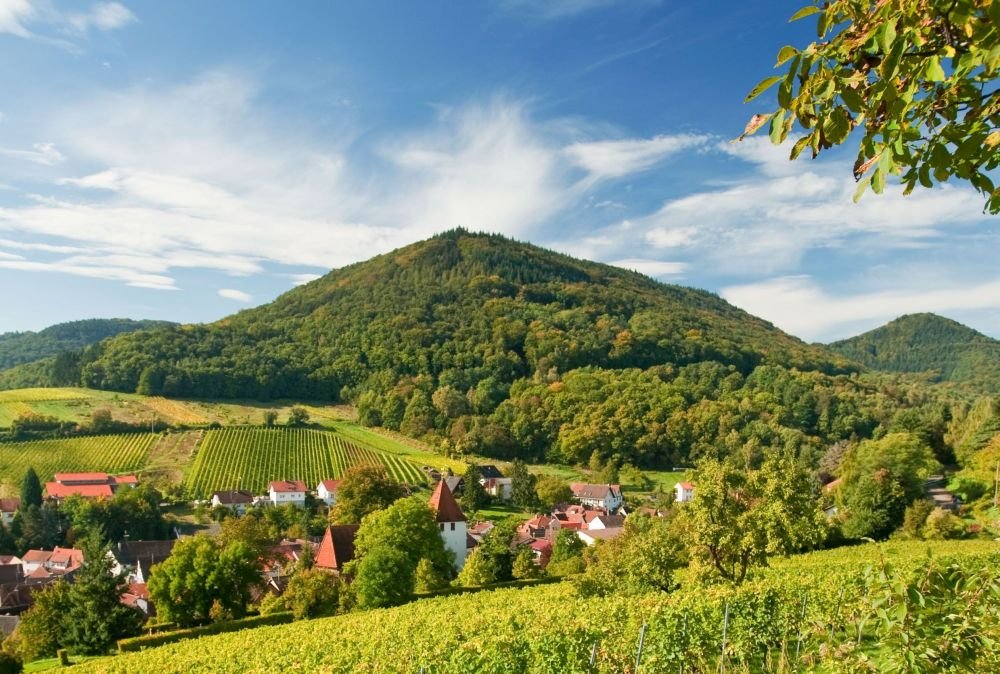UNESCO Biosphere Reserve Palatinate Forest (Pfälzerwald) and Northern Vosges
Forests, Viticulture and German-French Friendship

Located on the Franco-German border, the Northern Vosges (in France) and the Palatinate Forest (Pfälzerwald, in Germany) share a transboundary UNESCO biosphere reserve. Particularly characteristic are the dense forests, representing the largest contiguous forest area in Western Europe, the impressive sandstone cliffs, the almost one hundred castles and ruins, as well as numerous streams that meander through the valleys.
The cultural landscape, which has been shaped by generations of people, is the basis and lifeline for timber and forestry, agriculture, viticulture and tourism. In the world network, the cross-border biosphere reserve represents the habitats of low mountain range forests, vineyards, dwarf shrub heaths, moors, still and running waters.
The imposing sandstone rocks of the "Dahner Felsenland" are characteristic and important for tourism, whilst also providing habitats for rare animal and plant species. The sandstone area of the Vassau, hosting many medieval castle ruins on rock spurs, is one of the most impressive sandstone areas in all of Central and Western Europe. In addition to peregrine falcons and eagle owls, ravens breed again on the rock faces.
The Palatinate Forest is the only German biosphere reserve that is also an important wine-growing region, the "Haardtrand-Weinstraße". Thanks to the mild, dry climate, Mediterranean animal and plant species can also be found here. Altogether, some 250,000 people live in the transboundary biosphere reserve.
Contributions to sustainable development
The cross-border core area Adelsberg-Lutzelhardt, which is a natural forest reserve under both German and French law, is a real novelty in the whole of Europe. Wildlife corridors in the Palatinate Forest give larger mammals such as the wildcat and the lynx the chance to migrate and spread - thus the biosphere reserve is also of supra-regional importance for these animals.
The project "New Shepherds' Routes in the Palatinate", funded by the German government since 2018, aims to achieve the sustainable use of valuable open-land biotopes. The restoration and maintenance of old drift paths will promote migration and protect important habitats, for example for rare butterflies, grasshoppers, or ground-nesting birds. In addition, sheep flocks transport countless seeds and small animals via the fur of the animals.
International Partnerships
The transboundary UNESCO Biosphere Reserve, established as such in 1998, was the first of its kind in the European Union. Cross-border cooperation takes place in various areas on an every-day basis. The regular Franco-German biosphere farmers' markets, where up to 10,000 visitors can buy goods from the region produced in an environmentally friendly way, have broad public impact.
Facts
- Year of designation: 1992 (national), 1998 (cross-border)
- Federal states: Rhineland-Palatinate (Germany), Départments Bas Rhin and Moselle (France)
- Size: total 3,018 km² (38.7 km² core area and 492.6 km² buffer zone), German part: 1,809.7 km²
- Represented landscape: Southwest German strata, Triassic sandstone low mountain range
- Website of the German part: www.pfaelzerwald.de

